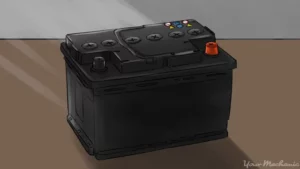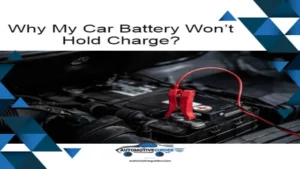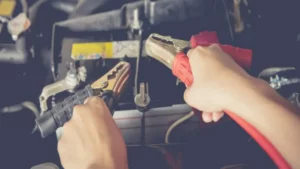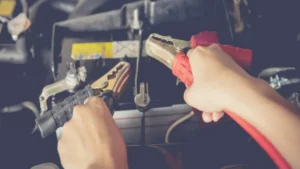Let’s face it, dead car batteries are a frustrating inconvenience, but they don’t have to ruin your day. If you have a portable car battery charger, you can jump start your vehicle quickly and easily. But if you’ve never used one before, you might be wondering where to start.
Don’t worry; it’s simpler than you think. In this step-by-step guide, we’ll walk you through the entire process of using a portable car battery charger. You’ll be back on the road in no time! So grab your charger, and let’s get started.
What You Will Need
If you find yourself stranded on the side of the road with a dead car battery, a portable car battery charger can be a lifesaver. But how do you use one? First, you’ll need to make sure you have all the necessary equipment. This includes the portable charger itself, jumper cables, and possibly a power source such as a wall outlet or another vehicle to “jump” your dead battery.
Once you have everything you need, it’s important to carefully read the instructions that come with your particular charger. Typically, you’ll need to connect the positive and negative cables to your battery, making sure to attach them in the correct order. Then, plug in the charger and let it work its magic.
Some chargers may require you to monitor the battery and adjust settings as needed, so be sure to follow the instructions carefully and stay alert during the process. With the right preparation and a bit of know-how, using a portable car battery charger can be a straightforward and stress-free experience.
Portable Car Battery Charger
If you plan on driving long distances, you need a portable car battery charger. It’s a handy device that can save you from getting stuck with a dead battery. But what do you need to buy to make sure you have the best charger for your needs? The first thing you should consider is the amperage of the charger.
Higher amperage chargers are typically faster and more efficient, but they can be more expensive. You also need to think about the type of battery you have, as some chargers are designed specifically for certain battery types. Additionally, consider the features you need, such as safety features like protection against overcharging or short circuits.
Ultimately, your choice of portable car battery charger will depend on your specific needs, the type of car battery you have, and your budget.
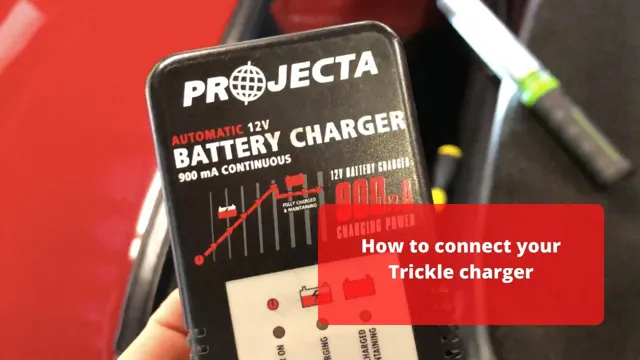
Car Battery
One of the essential components of your car is the battery. The battery helps your vehicle start, and without it, you are stuck. If you want to keep your battery functioning properly, you need to have some essential tools on hand.
First, you will require a set of wrenches and pliers, as well as terminal cleaning tools. A voltage tester is an excellent gadget to have on hand to test the battery’s strength. Additionally, it would help if you had distilled water and a funnel to add fluid to your battery.
Lastly, gloves and safety glasses to protect your hands and eyes while working on your car battery. With these tools, you will be able to maintain your battery’s quality and detect any potential issues before they become more significant problems.
Safety Precautions Before Starting
Before using a portable car battery charger, it’s essential to take some safety precautions to prevent any accidents. Firstly, you should read the instruction manual thoroughly and understand how to use the charger correctly. Ensure that the car engine is switched off and that the charger is not connected to any power source before starting.
Always wear protective gloves and goggles while handling the charger to avoid any possible electrical shock or battery acid splashes. Check the battery’s status and ensure that the terminals are clear of any corrosion and debris before charging. Confirm that the charger cable clamps are tightly connected to the battery’s positive and negative terminals before turning on the charger.
Never connect the clamps to the opposite terminals or mix up the colors, as this may cause irreparable damage to the battery or charger. Regularly check the charger, cables, and clamps, and replace damaged or worn parts immediately. Following these safety precautions will ensure that you can use your portable car battery charger safely and effectively.
Read the Manual
When it comes to using any kind of tool, machine, or device, your safety should always be the top priority. That’s why before starting anything, it’s crucial to read the manual. The manual contains valuable information on how to properly operate the equipment, avoid accidents, and perform maintenance tasks.
It may also include safety precautions specific to the device, such as wearing protective gear like gloves, goggles, or helmets. By carefully reading and following the instructions in the manual, you can avoid unnecessary accidents and ensure that you use the device correctly and safely. Remember, taking a few minutes to read the manual is worth the time and effort to avoid serious consequences.
So, before hitting the start button, make sure to familiarize yourself with the instructions in the manual.
Ensure Power is Off
Before starting any electrical work, it’s crucial to ensure that the power is off. Electricity can be extremely dangerous, and it’s not worth taking any risks. Make sure that you turn off the power supply to the area in which you’re working, either by flipping the corresponding switch at the electrical panel or unplugging any appliances or devices that might be in use.
If you’re not sure which switch to flip, it’s always best to turn off the power to the whole house just to be safe. Once you’re confident that the power is off, double-check by using a non-contact voltage tester. This will alert you to the presence of any live wires or electrical currents so that you can re-evaluate your approach before continuing.
Always put safety first when dealing with electricity, and don’t be afraid to call in a licensed electrician if you’re feeling unsure or overwhelmed. Remember, it’s better to be safe than sorry!
Wear Protective Gear
Wearing protective gear is a crucial safety precaution that should be taken before beginning any job or activity that poses a potential risk of injury. Protective gear includes items such as helmets, gloves, safety glasses, face masks, and hearing protection. These items are designed to reduce the risk of injury and can significantly reduce the severity of injuries if an accident does occur.
For example, wearing a hard hat can save you from a head injury if an object falls from above, or wearing safety glasses can prevent eye injuries from flying debris. It is important to choose the appropriate gear for the job and ensure that it fits correctly to provide maximum protection. Always remember, wearing protective gear is not only mandatory in some cases but also a responsible action to protect yourself from harm.
So, make sure to wear the appropriate protective gear for each job, and stay safe while working.
Connecting the Charger to Your Car Battery
If you’re wondering how to use a portable car battery charger, connecting it to your car battery is a crucial step. First and foremost, make sure that both the charger and your car are switched off before getting started. Find the positive and negative terminals of your car battery and use the red clamp to attach the positive end of the charger to the positive terminal, and the black clamp to attach the negative end of the charger to the negative terminal.
Ensure that the clamps are securely attached and tightened, as this is important for the charger to work effectively. Once everything is attached, turn your charger on and wait for it to fully charge your battery. It’s essential to follow these steps correctly to avoid damaging your car’s electrical system or risking injury.
Remember, always read the instructions carefully before using your portable car battery charger and consult with a professional if you’re unsure. With a bit of care, you’ll be able to charge your car battery quickly and efficiently, getting you back on the road in no time.
Locating the Battery
Connecting the Charger to Your Car Battery When it comes to connecting a charger to your car battery, the first thing you need to do is locate the battery. Depending on the make and model of your vehicle, the battery may be located in different areas. Most commonly, however, you can find it under the hood on the side closest to the front of the car.
Once you’ve located the battery, you’ll need to remove the plastic caps on the top of the battery to reveal the positive and negative terminals. The positive terminal is marked with a plus (+) sign, while the negative terminal is marked with a minus (-) sign. When connecting the charger, you’ll want to attach the red clamp to the positive terminal, and the black clamp to the negative terminal.
It’s important to make sure the clamps are securely attached to avoid any sparks or short circuits. With the charger connected, you can now turn it on and allow it to charge your battery. Remember to follow the instructions that come with your specific charger, and never leave the charger connected for too long, as this can damage your battery.
With these simple steps, you can easily connect a charger to your car battery and keep your vehicle running smoothly.
Connecting the Clamps
Connecting the charger to your car battery requires a few simple steps. First, make sure your car is turned off and the charger is unplugged. Next, locate the positive and negative terminals on your battery.
In most cars, the positive terminal will be marked with a plus sign and will be red, while the negative terminal will be marked with a minus sign and will be black. Next, connect the red clamp from the charger to the positive terminal on the battery. Then, connect the black clamp to the negative terminal on the battery.
Once everything is securely attached, plug in the charger and turn it on. The charger should begin charging the battery right away. It’s important to keep an eye on the charger and make sure it doesn’t overcharge the battery.
Once the battery is fully charged, turn off the charger and disconnect the clamps, starting with the negative clamp first. With these easy steps, you can connect your car battery to a charger and ensure a healthy and reliable battery for years to come.
Selecting the Correct Voltage and Amperage
When it comes to charging your car battery, selecting the right voltage and amperage is crucial. The voltage should match your car battery’s specifications, and the amperage should be within the recommended range. Using a charger with too high of a voltage or amperage can damage your battery and even cause a fire.
It’s important to read the label on your battery and the charger before connecting them to ensure compatibility. Once you’re sure they’re a match, connect the charger to your battery by attaching the red cable to the positive terminal and the black cable to the negative terminal. This process will keep your battery healthy and extend its lifespan.
Charging Your Car Battery
If you’ve ever been in a situation where your car battery suddenly dies and you’re stranded, a portable car battery charger can be a lifesaver. But how exactly do you use one? First, make sure the charger is compatible with your vehicle’s battery and follow any specific instructions provided by the manufacturer. Then, park your car in a safe location and turn off all electrical components.
Connect the charger’s positive clamp to the positive terminal on your battery and the negative clamp to the negative terminal. Turn on the charger and let it do its job, which usually takes several hours. Once the charger indicates that the battery is fully charged, disconnect the clamps in the reverse order in which you attached them.
It’s important to handle car batteries and chargers with care, as they can be dangerous if mishandled. By following these simple steps, you can charge your car battery and get back on the road in no time.
Setting the Timer
When it comes to charging your car battery, it is important to set a timer to ensure the battery does not overcharge. Overcharging can lead to damage to the battery, reducing its lifespan and potentially causing it to fail. To avoid this outcome, it’s best to set a timer that matches the battery’s charging specifications, which can typically be found in its manual.
This way, you can charge your battery without having to constantly monitor it, freeing up time for other tasks. Remember, just like with anything in life, moderation is key. Charge your battery enough to keep it running optimally, but not too much that it becomes overloaded and damaged.
With a bit of diligence, you can extend the life of your car battery, saving you both time and money in the long run.
Checking the Progress
When it comes to charging your car battery, checking the progress is crucial. It’s easy to assume that your battery is fully charged, only to find out later that it’s not. To avoid this situation, it’s best to check the progress periodically.
One of the easiest ways to do this is by using a multimeter. Connect the meter to the battery and make note of the reading. A fully charged battery should give a reading of 1
6 volts or higher. If the reading is below this level, then the battery is not yet fully charged. Keep charging it until it reaches the optimal level.
Checking the progress not only ensures that you won’t get stranded on the road, but it also extends the life of your battery, saving you money in the long run.
Disconnecting the Charger from Your Car Battery
Portable car battery chargers are a great tool to have for emergencies or when you need to charge your battery quickly. But, once your battery is fully charged, it’s important to disconnect the charger properly to avoid any damage or injury. The first step is to turn off the charger and unplug it from the power source.
Then, remove the positive (red) clamp from the battery terminal followed by the negative (black) clamp. It’s important to remove the negative clamp first to avoid any sparks or electrical shocks. Once both clamps are removed, take care to store the charger away safely.
Using a portable car battery charger can be a lifesaver, but it’s important to use it safely and properly to avoid any accidents or damage to your vehicle.
Turn Off the Charger and Unplug it
When it comes to disconnecting the charger from your car battery, it’s important to take the necessary steps to avoid any potential hazards. First and foremost, turn off the charger before unplugging it. This is crucial to prevent any electricity from flowing into your car battery while you’re removing the charger.
Next, unplug the charger from the electrical outlet and gently remove the clamps from the battery terminals. It’s important to note that you should never touch the clamps together, as this can create a dangerous spark. Instead, carefully place the clamps in a safe location away from the battery.
By taking these precautions, you can safely and effectively disconnect the charger from your car battery without any accidents. Remember to always prioritize safety first and follow the instructions provided by your charger manufacturer.
Disconnect the Clamps
Now that your car battery is fully charged, it’s time to disconnect the clamps. Start by turning off the charger and unplugging it from the outlet. Then, remove the negative clamp that you attached first.
This is the black clamp that should be connected to the negative terminal of your car battery. Next, remove the positive clamp that is attached to the positive terminal of your car battery. This red clamp should have been attached second.
Remember to never let the clamps touch each other during this process, as this can cause sparks and damage to your vehicle’s electrical system. Once you have disconnected both clamps, you can safely store the charger until you need it again. Disconnecting the charger from your car battery is an important step in the charging process, so be sure to follow these steps carefully to ensure safe and effective charging.
Conclusion
So there you have it, my fellow car enthusiasts! Using a portable car battery charger may seem daunting at first, but with a little bit of patience, a dash of common sense, and a sprinkle of wit, you’ll be up and running in no time. Just remember to read the instructions carefully, follow the safety precautions, and never let your charging skills die out. Who knows, you may even impress your mechanic with your newfound knowledge.
Happy charging!”
FAQs
What is a portable car battery charger and how does it work?
A portable car battery charger is a device that uses electrical energy to charge a car battery. It works by connecting its cables to the terminals of the battery and supplying a current to recharge it.
How long does it take to charge a car battery with a portable charger?
The charging time of a portable car battery charger depends on the capacity of the battery and the output power of the charger. Typically, it can take from a few hours to overnight to fully charge a car battery.
Can a portable car battery charger damage my car’s electrical system?
No, a portable car battery charger is designed to protect against overcharging and short circuits, which can cause damage to the car’s electrical system. However, it’s important to use a charger that is compatible with your car’s battery type and rated for its voltage and amperage.
What are the different types of portable car battery chargers available in the market?
There are several types of portable car battery chargers, including trickle chargers, jump starters, and multi-purpose chargers. Trickle chargers provide a low current charge to maintain the battery’s charge level, while jump starters provide a high current boost to start a dead battery. Multi-purpose chargers can perform both functions and may include additional features like a built-in compressor or power inverter.
Can I use a portable car battery charger to charge other devices like smartphones or laptops?
Some portable car battery chargers may have USB ports or other outlets that allow you to charge other devices, but it’s important to check the specifications of the charger to ensure that it’s safe and effective for charging these devices.
How do I properly maintain my portable car battery charger?
To maintain your portable car battery charger, you should read the manufacturer’s instructions and follow the recommended maintenance procedures. These may include periodically checking the battery charge level, cleaning the terminals and cables, testing the charger’s output voltage and amperage, and storing the charger in a cool and dry place.
Can a portable car battery charger replace a regular car battery?
No, a portable car battery charger is not a replacement for a regular car battery, but it can help to keep your battery charged and extend its life. If your car battery needs to be replaced, it’s important to consult a professional mechanic and choose a replacement battery that is compatible with your car’s specifications.

